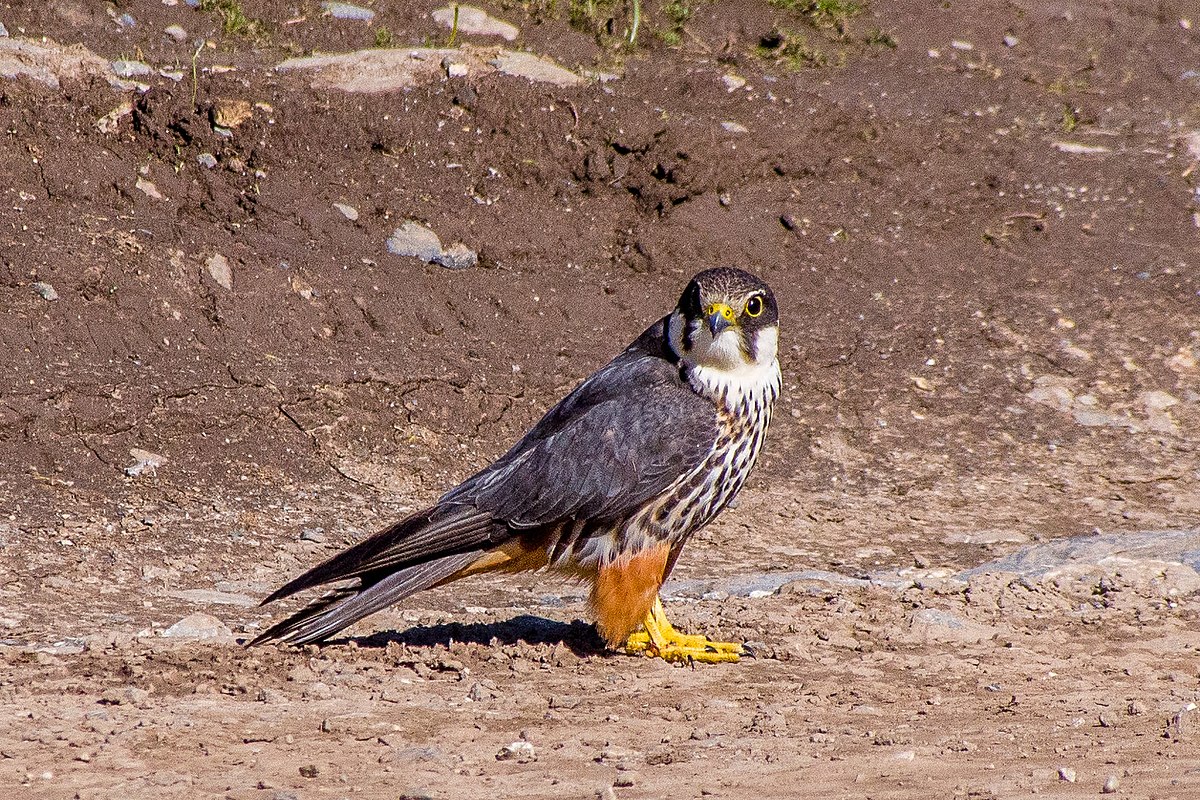Single note calls are confusing.
Übung| Bird | Description | Audio |
 Baumfalke / Eurasian hobby (Falco subbuteo) ■■
Baumfalke / Eurasian hobby (Falco subbuteo) ■■ |
Automatically generated from Xeno-Canto recording.
Call: | ♫ |
| nicht musikalisch | ||
| trommeln | ||
|
|
trommeln nicht musikalisch fast low (1-3 KHz) .
Song: Other: ‘Drumming’ is the sound that Great Spotted Woodpeckers make by hammering their bills against dead wood 10-20 times over 2-3 seconds. The sound resonates in the dead wood and can be heard over large distances. This drumming acts as an advert and is used by Great spotted Woodpeckers and other woodpecker species instead of a song. [From the GardenBird web site] Nabu: Manchmal, bei strahlendem Sonnenschein, fangen die Spechte schon im Dezember an zu trommeln. [NABU Vogel des Jahres 1997] Call: Nabu: Das bekannteste Geräusch des schwarz-weißen Spechtes ist aber wohl sein kurzes, aber häufiges Trommeln. [Link] |
♫

|
 Eisvogel / Common kingfisher (Alcedo atthis) ■■
Eisvogel / Common kingfisher (Alcedo atthis) ■■ |
Automatically generated from Xeno-Canto recording.
Call: |
♫

|
| einfach rhythmisch | ||
|
|
einfach rhythmisch fast low-high (2-10 KHz) .
General: Higher-pitched than great tit, sometimes repetitive 1- and 2-note tunes like them, sometimes simple melodies, usually pure, sometimes chirpy or raspy. Song: |
♫

|
| lallen | ||
 Haubenmeise / European crested tit (Lophophanes cristatus) ■■
Haubenmeise / European crested tit (Lophophanes cristatus) ■■ |
lallen einfach rhythmisch fast high (3-9 KHz) .
Higher-pitched than great tit - how distinguish from coal tit, etc?
Song: |
♫

|
 Kohlmeise / Great tit (Parus major) llhllh ■■
Kohlmeise / Great tit (Parus major) llhllh ■■ |
einfach rhythmisch slow medium (1-5 KHz) .
Said to have a repertoire as a species of 50 or more different songs, albeit simple ones, up to 10 per individual.
Females prefer a male with a large repertoire. One two-note song sounds like a squeaky bed.
Song: Nabu: Die erste Vogelart, die wir im Jahr hören, ist meistens die Kohlmeise mit ihrem typischen Läuten: "Zip Zäh" oder "Zip zip Zäh". [NABU Experte Lars Lachmann bei Deutschlandfunk Nova] | ♫ |
| Triller | ||
|
|
Triller einfach rhythmisch slow high (3-9 KHz) .
General: High-pitched, often descending (hhll), occasionally ascending. "Christina compares it to a ping-pong ball dropping. [In Januar singt die Kohlmeise als erster Vogel in Deutschland], dann kommt die Blaumeise dazu. Song: |
♫

|
| stereotypisch melodisch | ||
| Triller | ||
|
|
Triller stereotypisch melodisch fast high (3-9 KHz) .
|
♫

|
Übung
♫ Lösung
Gebirgsstelze / Grey wagtail (Motacilla cinerea) XC767550 - Grey Wagtail - Motacilla cinerea - song with trills and a cheek-cheek.
♫
Lösung
Baumfalke / Eurasian hobby (Falco subbuteo) Meint Baumfalke bei Rosinli, Hittnau.
♫
Lösung
Gebirgsstelze / Grey wagtail (Motacilla cinerea) XC767550 - Grey Wagtail - Motacilla cinerea - song with trills and a cheek-cheek.
♫
Lösung
Baumfalke / Eurasian hobby (Falco subbuteo) Meint Baumfalke bei Rosinli, Hittnau.
♫
 Lösung
Haubenmeise / European crested tit (Lophophanes cristatus) European Crested Tit song XC560609-european-crested-tit-lophophanes cristatus2020.05.20 11.51 01 song.
♫
Lösung
Haubenmeise / European crested tit (Lophophanes cristatus) European Crested Tit song XC560609-european-crested-tit-lophophanes cristatus2020.05.20 11.51 01 song.
♫
 Lösung
Blaumeise / Eurasian blue tit (Cyanistes caeruleus) XC555029 blaumeise.
♫
Lösung
Blaumeise / Eurasian blue tit (Cyanistes caeruleus) XC555029 blaumeise.
♫
 Lösung
Buntspecht / Great spotted woodpecker (Dendrocopos major) Great spotted woodpecker drumming XC625181 buntspecht drumming.
♫
Lösung
Buntspecht / Great spotted woodpecker (Dendrocopos major) Great spotted woodpecker drumming XC625181 buntspecht drumming.
♫
 Lösung
Eisvogel / Common kingfisher (Alcedo atthis) XC839045 - Common Kingfisher - Alcedo atthis - song - Viana do Castelo, Portugal.
♫
Lösung
Kohlmeise / Great tit (Parus major) Kohlmeise gesang in Fehraltorf llhllh.
♫
Lösung
Eisvogel / Common kingfisher (Alcedo atthis) XC839045 - Common Kingfisher - Alcedo atthis - song - Viana do Castelo, Portugal.
♫
Lösung
Kohlmeise / Great tit (Parus major) Kohlmeise gesang in Fehraltorf llhllh.
♫
 Lösung
Sumpfmeise / Marsh tit (Poecile palustris) XC727754 - Marsh Tit - Poecile palustris.
Lösung
Sumpfmeise / Marsh tit (Poecile palustris) XC727754 - Marsh Tit - Poecile palustris.